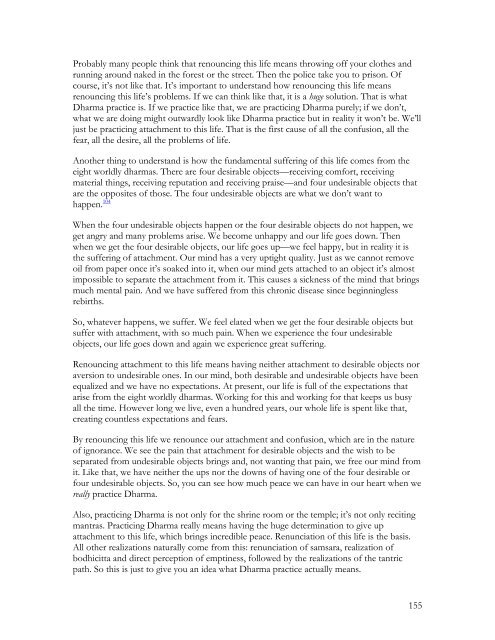Lama Zopa Rinpoche
55OTzl52A
55OTzl52A
Create successful ePaper yourself
Turn your PDF publications into a flip-book with our unique Google optimized e-Paper software.
Probably many people think that renouncing this life means throwing off your clothes and<br />
running around naked in the forest or the street. Then the police take you to prison. Of<br />
course, it’s not like that. It’s important to understand how renouncing this life means<br />
renouncing this life’s problems. If we can think like that, it is a huge solution. That is what<br />
Dharma practice is. If we practice like that, we are practicing Dharma purely; if we don’t,<br />
what we are doing might outwardly look like Dharma practice but in reality it won’t be. We’ll<br />
just be practicing attachment to this life. That is the first cause of all the confusion, all the<br />
fear, all the desire, all the problems of life.<br />
Another thing to understand is how the fundamental suffering of this life comes from the<br />
eight worldly dharmas. There are four desirable objects—receiving comfort, receiving<br />
material things, receiving reputation and receiving praise—and four undesirable objects that<br />
are the opposites of those. The four undesirable objects are what we don’t want to<br />
happen. 104<br />
When the four undesirable objects happen or the four desirable objects do not happen, we<br />
get angry and many problems arise. We become unhappy and our life goes down. Then<br />
when we get the four desirable objects, our life goes up—we feel happy, but in reality it is<br />
the suffering of attachment. Our mind has a very uptight quality. Just as we cannot remove<br />
oil from paper once it’s soaked into it, when our mind gets attached to an object it’s almost<br />
impossible to separate the attachment from it. This causes a sickness of the mind that brings<br />
much mental pain. And we have suffered from this chronic disease since beginningless<br />
rebirths.<br />
So, whatever happens, we suffer. We feel elated when we get the four desirable objects but<br />
suffer with attachment, with so much pain. When we experience the four undesirable<br />
objects, our life goes down and again we experience great suffering.<br />
Renouncing attachment to this life means having neither attachment to desirable objects nor<br />
aversion to undesirable ones. In our mind, both desirable and undesirable objects have been<br />
equalized and we have no expectations. At present, our life is full of the expectations that<br />
arise from the eight worldly dharmas. Working for this and working for that keeps us busy<br />
all the time. However long we live, even a hundred years, our whole life is spent like that,<br />
creating countless expectations and fears.<br />
By renouncing this life we renounce our attachment and confusion, which are in the nature<br />
of ignorance. We see the pain that attachment for desirable objects and the wish to be<br />
separated from undesirable objects brings and, not wanting that pain, we free our mind from<br />
it. Like that, we have neither the ups nor the downs of having one of the four desirable or<br />
four undesirable objects. So, you can see how much peace we can have in our heart when we<br />
really practice Dharma.<br />
Also, practicing Dharma is not only for the shrine room or the temple; it’s not only reciting<br />
mantras. Practicing Dharma really means having the huge determination to give up<br />
attachment to this life, which brings incredible peace. Renunciation of this life is the basis.<br />
All other realizations naturally come from this: renunciation of samsara, realization of<br />
bodhicitta and direct perception of emptiness, followed by the realizations of the tantric<br />
path. So this is just to give you an idea what Dharma practice actually means.<br />
155


